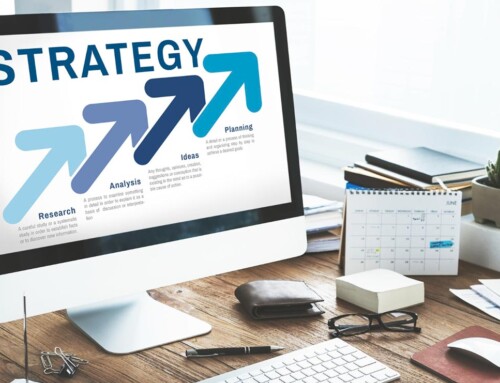Contents
So, your business has reached a critical stage where you can think about expanding. There are different ways to define the stages a small business goes through in its path to success. Some models place growth as the third stage, some the second — it doesn’t really matter. What does is the fact that your business has survived and thrived. Kudos. Of course, it’s a bit early to sit back and enjoy the view. Knowing how to grow a small business can be the difference between rapid progress and years of slow growth.
You’ll need to navigate the crucial process of growing your business. For that, you’ll have to use all the tools and strategic advantages you have to make things happen faster and better. There are ways you can ensure better results from your efforts at the business expansion. I’ve gathered some of the most vital steps you need to take in this article. Even if you’ve implemented some of them, you may find details that inspire you to improve your current tactics. I’ll take the first section to discuss four over-arching business growth strategies. After that, you can find tricks and tactics to help your business grow.
The 4 Business Growth Strategies
You can use different tactics to ensure your business growth is smooth and quick. This article lists 8 of the more essential ones. But there are tactics, and then there are strategies. Businesses usually use one of the 4 growth strategies that shape the more minor decisions as you continue to scale.
Market Penetration
In market penetration, you will try to sell the products you already have to a new market. A new market can be a new geographical location like provinces, territories, or states outside your headquarters. But a new market can also be a different segment of the market than the one you’ve been targeting. Segments can be considered in terms of age, gender, or income. For example, suppose you may have targeted your artisanal products at the upper-middle class. You can now consider penetrating the middle-class market by offering discounts or package deals. Despite reducing the profit margin, changing prices is actually a market penetration strategy many businesses use to trigger growth.
Product Development
If the previous strategy involves selling the same products to a new market, this one is the opposite. In product development, your goal is to extend your product line, coming up with more goods or services to sell to your current market. Of course, you don’t have to invest heavily in research and development to come up with an entirely new product. Instead, you can simply add new features to your existing products. This gradual product development can be ideal for very small businesses that want to take things slowly as they grow.
Marketing Development
The main idea here is to increase sales and grow by focusing on marketing. Instead of going for a new product line or a new market, this strategy involves new ways to market your business. There are different ways you can go about marketing development. One of the more straightforward ones is to add new channels to your marketing strategy. For example, if you’ve been promoting your business mainly on Facebook, it may be high time to give Instagram or Pinterest a chance. Another way to develop your marketing for growth is rebranding. This one is actually a risky move, and while some companies have done very well afterward, most have suffered. A far safer alternative would be to enhance your branding guidelines. These tips on branding for small businesses can get you noticed without breaking the bank. However, if you decide on rebranding, you should think about consulting rebranding experts.
Organic Growth
This is the best way for any business to grow, but it’s also the hardest to pull off. Organic growth can be boiled down to “doing things well enough and you’ll be noticed.” Just as organic traffic is the number of users that didn’t follow any ads to visit your website, organic growth means a type of growth not driven by placing ads or commercials. In this growth strategy, you must focus on “inbound marketing,” putting most of your effort into content, SEO, and funnel design.
Hire and Delegate
Up until now, you’ve been the core and center of your entire company, almost an army of one. You’ve handled all the main tasks, whether in marketing, sales, HR — and that’s not even counting the time you spend on actually working. Granted, this means you’ll get great consistency in all aspects, but it’s not sustainable as you continue to evolve and grow.
Now that you have more revenue and more customers, it’s time to hire the right talent. Instead of doing everything yourself, you should focus on finding the best match for each task from any talent pool you can access. Finding a good match is essential whether you’re getting the word out through job postings or going by recommendation and networking. With the correct person on board, you’ll be free to delegate and manage instead of handling every detail. This may take some time for you to adjust to, but delegating can be a formidable force driving more sales.
Of course, you won’t be expanding your team from 3 to 43 overnight. The hiring process should start with positions that put the most strain on your time and resources. The first step is identifying which part of your business needs the most attention. In many cases, it’s marketing and sales that take up the most time. If that’s the case with your business, you know what type of talent you should add to your team.
Expanding your team along with your business can be a significant advantage. However, hiring too many employees may drain your budget when you need it the most. That’s why it’s essential to optimize the efficiency of each member of your team by giving them the proper tools for their job. Putting a CRM in place along with employing sales reps is a better use of your budget than just hiring the talent — both in the short and long run. I’ve discussed CRMs and their role in growing your business in this article, so be sure to read that section.
Update your Business Plan
This is one of the critical parts of any attempt at business growth. The business plan you wrote when you started is undoubtedly excellent because it got you this far. But now, you will need to update your business plan centering it around growth. In this new business plan, you need to consider that your business has passed the break-even point, finally leading to a positive cash flow. That means planning for investment.
Part of the business growth plan will be about which sections of your business should receive investment sooner. Defining and reallocating your budget is central to the entire expansion effort. To formulate a proper budget, make sure you have mapped out and verified your revenue streams. How much are you earning, and from what channels? Plus, answering these questions should help you get a better sense of how your business will look like in the future.
How your business will actually grow is also part of the new business plan you will write. Are you going to provide more products for sale? Will you try expanding to new markets? Will you only focus on improving your marketing strategy? These are the questions that you need to ask yourself if you want your business to grow. Your answers will be different based on your business niche and how you’ve done in the past.
Planning to grow your small business also means defining ways to measure your success. With the speed at which everything is moving these days, any business must stay on its toes, keeping flexible and agile. “Agile” is one of those buzzwords people have been throwing around a lot. What I mean by it is that you should be able to judge how your business is doing without waiting for the quarter reviews or annual analyses. In a very small business with a handful of employees, it’s pretty easy to keep track of your performance. You know precisely how you’re doing because you’re the one doing almost everything. However, now that you’re planning on growing, things will start to change. You’ll need to define some Key Performance Indicators (KPIs) to help you and your employees determine how well the business is functioning. Defining KPIs can be as simple as writing down which data you used to look at before starting to grow. But you should also consider putting some of your budget toward getting more useful KPIs.
Use a CRM and Marketing Tool
Obviously, you’re on top of everything at the moment, and that’s why you’re thinking of expanding. That’s going to change some of the rules in the game. Even if your raw power and energy are keeping things organized and together now, things will fall apart as you grow. I’m sure you’ve been hearing and reading about scalability a lot. This is precisely where you need a scalable solution to organize and optimize your entire business. Of course, I’m talking about Customer Relationship Management systems. CRM solutions are essential to running a successful business, and that goes double when you’re talking about business expansion.
When starting to grow as a business, you’ll need a way of organizing data into actionable info. That means finding a simple, scalable, and stable Customer Relationship Management system. A CRM is a software system that gathers all the information available on prospects and customers in one place. A CRM system like RunSensbile even integrates your email marketing and sales funnel. That will ensure no opportunity is lost and that all prospects are handled correctly. Our CRM and marketing tool also lets you see patterns emerging from the info, giving you greater insight into your existing and emerging buyer personas. Of course, the strategic advantages that a CRM solution can bring to the table are many more than these. A more in-depth guide on CRM systems can give you a better context on the subject.
Reconsider your Homepage and Landing Pages
Your website could be better. No, I haven’t seen it, but that’s true for almost every website. You can think of your website as being constantly under construction. That means fixing and enhancing things in small steps: a font change here, a decluttering there — you get the idea.
The design and layout of your homepage and landings can seriously impact your sales. If you plan on growing, you will need to grow your lead generation and customer base as well. You must make sure you have done everything you can to maximize the chances of attracting new customers. They will be the drive to your growth. Answering the demands of more customers is actually one of the reasons many small businesses owners decide to grow.
Many business owners keep putting website design on the back burner again and again. Others do try to fix things, but their efforts are too random and impulsive to work. Minor, consistent improvements on essential parts of your website aren’t that hard to plan. Follow these simple steps to ensure you get the most out of your website:
Declutter your Homepage
Minimalism has been popular for so long because it works. Instead of a homepage filled to the brim with info on you and your business, try to get only the essentials, directing them to other pages for details like features.
Choose the correct color palette
If you’ve already done your branding, you probably have an idea about what colors are part of your palette. Try to stick to them when working on your website.
Don’t get too fancy
Using a lot of cool, fancy plugins and widgets can seem like a great idea, but most of the time it’s not. While the correct plugin can make things easier for your visitors, it can also slow down your website’s load time and functionality to the point where people just leave.
Improve your Customer Retention Rate
Not all growth comes from new markets and new customers. In fact, you’ll have better chances at increasing sales and expanding your business by keeping your current customers happy. Data suggests that returning customers make up most of a small business’s sales. Keeping them coming back, however, means putting in the time and effort to meet their demands and ensure their loyalty. There are more than a few guidelines on customer retention. Here, I’ll focus on a few vital steps your business must consider while expanding:
Reliable Customer Support
This is one of the areas where adding new employees is the right call. No matter your business, a customer support department can do wonders for your customer retention rates. Creating a support“department” isn’t anything intimidating. Just one or two support personnel can go a long way if your CRM provides the right tools for customer support. RunSensible, for example, lets your support team record problems, complaints, and comments from customers. The records can speed up the support process and make you better understand how your customers interact with your products.
Social Media Presence
One way to increase customer satisfaction is to keep an active social media presence and answer every comment or message. It’s very affordable and surprisingly effective. By showing your potential and existing customers that you care about them and their views, you will gain their trust and keep them satisfied. Let me use myself as an example. When I complain about a product I’ve paid for, 8 times out of 10, I just want to feel like I’m heard. If I feel like the company does care about me as a customer, I’m usually willing to give them another chance or overlook some of the problems. So, make your customers feel appreciated, heard, and engaged by following these guidelines on how to respond to customer complaints. A big part of that can be done using social media. If you’re also interested in running social media campaigns, consider hiring a social media officer to handle everything.
Put more Effort on Content
With great growth comes great content, or at least that’s how it should be. Your blog and other content channels need to be more active than ever before. Naturally, it won’t be easy to increase your content creation overnight. It’s going to need careful, strategic planning and budget allocation. Some small businesses choose to hire freelance content creators at this point. Their rates are very affordable, and if you’re careful in your search, you can find someone who will do a good job. Some companies specialize in providing quality content on any scale. They definitely cost more, but the content they create will be more efficient at getting you noticed and gaining visitors’ trust.
If you’re comfortable with writing and think you can handle doing more, then you should. But a growing business needs a lot of attention and time. A better way may be to create the content in-house. There are advantages to bringing someone on board to create content that matches your brand and buyer persona. They’ll get to know your company and its offerings intimately, and that will make for much more compelling content.
If you’re operating on a limited budget, you can just focus on your blog. Writing blog posts is the most efficient content creation — you can reuse the articles as ebooks, which gives you more lead magnets. You can also share excerpts on social media platforms like LinkedIn and Facebook. So, if you have to choose one type of content, blog posts are the way to go.
Offer more Services
Growing your business can mean offering more, expanding your products and services along with your business. I have already discussed product development as a growth strategy. Here I’m going to offer some details and examples that help put things into context.
Suppose you have a small graphic design company that’s good at creating logos. Creating powerful but affordable logos is your unique value. You know your customers have only started to brand (or rebrand) their companies. So, how about offering to provide them with a catchy slogan that goes with the logo and their brand? That’s sure to appeal to most of the customers and prospects you’re working with, not to mention previous ones. Choosing the correct avenue of expansion can bring you closer to your goals that much faster.
The best way to increase your offerings won’t necessarily be easy. Some industries are more complex to expand in than others. But as a rule of thumb, adding services on top of products may get results. If you package and sell premium tea you import yourself, why not create a “tea of the month” service? Combined with a brilliant and systematic email campaign, it will see your customer base and conversion rates rise faster than ever. Try to find a way to capitalize on your unique value. Draw on your expertise and any new talent you may add to your team to give people more value. That’s how you’ll form a sustainable basis for enlarging your business.
Stick to your Brand
At this point in your business lifecycle, you’ve probably finished branding. Not that it’s ever too late to brand or rebrand your company. If you’re still not committed to branding, you may want to give this guide on branding for small businesses a read. However, if you’ve settled on your business brand, make sure you stick to it as you grow.
Some companies decide to start their growth by rebranding. That may turn out to be a blessing or a curse, depending on so many different factors. That’s why there are rebranding specialists and even some marketing companies that only handle rebranding cases. So, unless you’ve really thought things through and are committed to rebranding, I suggest you keep to the brand that helped your business make it this far.
Implementing Business Growth Strategies and Tactics
Getting the most out of these strategies and tactics requires access to the right tools. The first investment you need to consider is in tools like CRM, analytics, and marketing tools. There are some tools that offer combined functionality, providing most of the services you need in one place. RunSensible, for example, is a CRM system plus a marketing and sales tool. Being cloud-based and affordable, it’s perfect for small businesses who are looking to grow.
Disclaimer: The content provided on this blog is for informational purposes only and does not constitute legal, financial, or professional advice.






